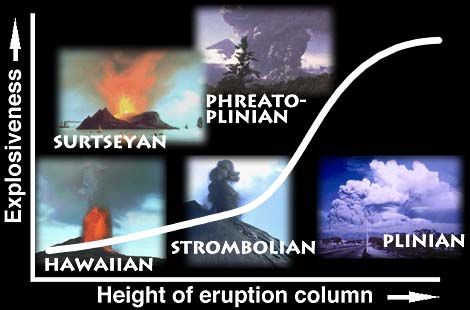Volcano Terminology
The study of volcanoes, or Volcanology, includes many odd
terms.How many do you know?
The term nuée ardente, or
"glowing cloud" was first used by La Croix (1904)
in his description of the volcanic flows he observed in
the 1902 eruption of Mt Pelée, a historically
active volcano on the island of Martinique.
There are many different types of volcanic eruptions and landforms.
They can be classified according to the
degree of "explosiveness"
and the height of the eruption column:
Investigate each type by clicking on a picture
each link will open its own browser window

Volcanoes in Action
 Watch a computer animation of a Plinian style eruption,
modeled after the AD 79 eruption of Vesuvius which destroyed
the city of Pompeii. Use the animation to understand the
formation of Plinian eruption columns and how their collapse
generates pyroclastic flows [287k QuickTime movie].
Watch a computer animation of a Plinian style eruption,
modeled after the AD 79 eruption of Vesuvius which destroyed
the city of Pompeii. Use the animation to understand the
formation of Plinian eruption columns and how their collapse
generates pyroclastic flows [287k QuickTime movie].
Shapes of Volcanoes
Their general "shape" can help you classify volcanoes by a
measure known as the aspect ratio, or the ratio of
height to width. Since this value is a ratio, it does not
matter if we measure it in actual dimensions
(feet, meters, etc) or if we use a ruler on a photograph.
Use the Volcano Web tool to measure the aspect
ratio of several volcanoes. (Requires
Shockwave)

